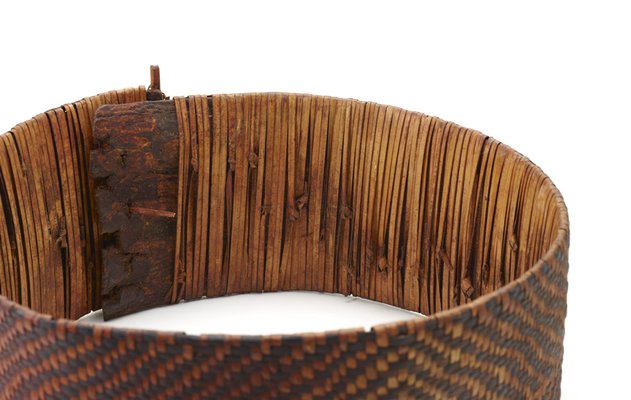


-
Details
- Place where the work was made
-
Tari
→
Tari-Pori District
→
Hela Province
→
Papua New Guinea
- Cultural origin
- Huli people
- Dates
- mid 20th century
collected 1969 - Media categories
- Botanical material , Ceremonial object
- Materials used
- tree bark, twill weave pattern in split rattan and black fern frond
- Dimensions
-
overall 87.0 cm length; 26.5 to 28.2 cm diameter; 12.2 to 13.3 cm width
:
0 - Whole, 12.2 cm (4 13/16"), width of woven belt at widest point
0 - Whole, 87 cm (34 1/4"), length of bark (approx.)
0 - Whole, 13.3 cm (5 1/4"), overall width of belt
0 - Whole, 26.5 cm, smallest diameter
0 - Whole, 28.2 cm, largest diameter
- Credit
- Gift of Stan Moriarty 1977
- Location
- Not on display
- Accession number
- 649.1979
- Copyright
- © Huli people, under the endorsement of the Pacific Islands Museums Association's (PIMA) Code of Ethics
- Share
-
-
About
The Huli is the largest cultural group in the southern highlands and society is grounded in the landscape of the valleys of the Tamari River basin. Myths describe the creation of the landscape by ancestral spirits and rituals link daily life with that of the spiritual world. The 'màli' ritual used to be performed to honour the clan's evil spirits that have the power to kill enemies in battle. 'Màli' is also the Huli word for dance, describing the sideways jumping of men with drums.
'Màli' dancers today are still adorned in ceremonial dress that includes human hair wigs, layers of looped string aprons, woven armbands and a 'bàeahago' (man's dancing belt). The 'bàeahago' is decorated with a striking geometric zig-zag pattern known as 'gīlini gīli', which is made from plaited cane and 'yàgua' (black fern frond). 'Gīlini gīli' is also used around arrow-heads, axe-heads and killing-picks. It denotes the up and down movement of the 'màli' dance.
[Exhibition text for 'Plumes and pearlshells: art of the New Guinea highlands', AGNSW, 2014]
-
Exhibition history
Shown in 1 exhibition
Plumes and pearlshells: art of the New Guinea highlands, Art Gallery of New South Wales, Sydney, 30 May 2014–10 Aug 2014
-
Bibliography
Referenced in 1 publication
-
Natalie Wilson (Editor), Plumes and pearlshells: art of the New Guinea highlands, Sydney, 2014, 120 (colour illus.), 162. cat.no. 64
-
